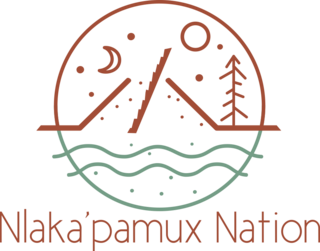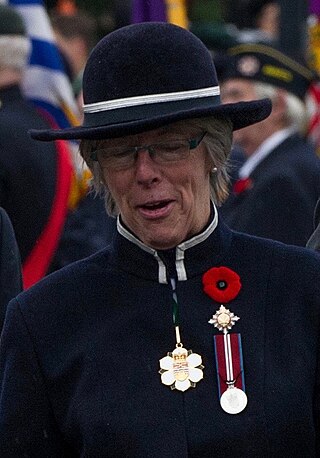Murphy Orlando Shewchuk is a Canadian writer. He is a past National President of the Canadian Authors Association. He currently resides in Merritt, BC.

The Kettle Valley Railway was a subsidiary of the Canadian Pacific Railway (CPR) that operated across southern British Columbia, west of Midway running to Rock Creek, then north to Myra Canyon, down to Penticton over to Princeton, Coalmont, Brookmere, Coquihalla and finally Hope where it connected to the main CPR line.

Merritt is a city in the Nicola Valley of the south-central Interior of British Columbia, Canada. It is 270 km (170 mi) northeast of Vancouver. Situated at the confluence of the Nicola and Coldwater rivers, it is the first major community encountered after travelling along Phase One of the Coquihalla Highway and acts as the gateway to all other major highways to the B.C. Interior. The city developed in 1893 when part of the ranches owned by William Voght, Jesus Garcia, and John Charters were surveyed for a town site.
Yale-Lillooet was a provincial electoral district for the Legislative Assembly of British Columbia, Canada.

Monck Provincial Park is a provincial park in British Columbia, Canada, located at Nicola Lake near the town of Merritt. The park's campground is one of those which accepts reservations. Activities including fishing, camping and hiking. Natural features other than Nicola Lake include lava beds associated with the Chilcotin Group.

The Douglas Lake Cattle Company is Canada's largest working cattle ranch, usually known as the Douglas Lake Ranch. Founded June 30, 1886, it has been operating continuously since. This date also marks the completion of the last leg of the first transcontinental rail line of the Canadian Pacific Railway from Montreal to Vancouver.

The Merritt Centennials are a Junior 'A' ice hockey team based in Merritt, British Columbia. They were members of the Interior Division of the British Columbia Hockey League (BCHL). Starting in the 2024–25 season, the Centennials will be joining the Kootenay International Junior Hockey League (KIJHL), and will become members of the Bill Ohlhausen Division. The franchise was established in Kamloops in 1961 and moved to White Rock in 1973 when the WCHL's Vancouver Nats moved to Kamloops and became the Chiefs. The Centennials settled in Merritt midway through the 1973–74 season. They play their home games at the Nicola Valley Memorial Arena.
School District 58 Nicola-Similkameen is a school district in British Columbia.This includes the major centres of Merritt and Princeton.
Scouting in British Columbia has a long history, from the 1900s to the present day, serving thousands of youth in programs that suit the environment in which they live.

The Thompson Plateau forms the southern portion of the Interior Plateau of British Columbia, Canada, lying to the west of Okanagan Lake, south of the Thompson River and east of the Fraser River. At its most southern point the plateau is squeezed by the mountainous terrain of the Cascade Range abutting closer to the Okanagan Valley. Its southwestern edge abuts the Canadian Cascades portion of that extensive range, more or less following the line of the Similkameen River, its tributary the Tulameen River, and a series of passes from the area of Tulameen, British Columbia to the confluence of the Thompson River with the Nicoamen River, a few kilometres (miles) east of Lytton, British Columbia, which is in the Fraser Canyon. Its northeastern edge runs approximately from the city of Vernon, British Columbia through the valley of Monte Creek to the junction of the same name just east of the city of Kamloops. Northeast of that line is the Shuswap Highland.

The Nicola River, originally French Rivière de Nicholas or Rivière de Nicolas, adapted to Nicolas River, Nicola's River in English, is one of the major tributaries of the Thompson River in the Canadian province of British Columbia, entering the latter at the town of Spences Bridge. It is named for Nicola (Hwistesmexteqen) the most famous chief of the joint community of Nlaka'pamux and Okanagan bands, founded by his father and today known as the Nicolas,, as well as its basin, which is known as the Nicola Country. It drains most of the northern Thompson Plateau, beginning near the very eastern edge of the plateau only 30 kilometres (19 mi) northwest of Kelowna, and flows from there more or less westward to feed Douglas Lake and Nicola Lake, with about 15 kilometres (9 mi) of the river's length between those two lakes. Nicola Lake at 20 kilometres (12 mi) long is the largest in the basin; the Nicola River enters at 3/4 way of its length up from its outlet, 10 kilometres (6 mi) downstream from which is Nicola Valley centre and Coquihalla Highway city of Merritt. From there the river flows 60 kilometres (37 mi) northwest to the Thompson, and is followed on that route by British Columbia Highway 8 and a spur line of the Canadian Pacific Railway.
The Scwʼexmx Tribal Council, officially referred to until May 27, 2019 as Nicola Tribal Association, also known as the Nicola Tribal Council and the Nicola Valley Tribal Council, is an official First Nations Tribal Council composed of bands in the Nicola Valley, Thompson Canyon and Fraser Canyon areas of the Canadian province of British Columbia. It is one of three tribal councils of the Nlakaʼpamux (Thompson) people, the other two being the Nlakaʼpamux Nation Tribal Council and the Fraser Canyon Indian Administration. The Lytton First Nation and Lower Nicola Indian Band community, does not belong to any of the three Tribal Councils.
The Shackan Indian Band is a Nlaka'pamux First Nations government located in the Nicola Country of the Southern Interior region of the Canadian province of British Columbia. It is a member of the Scw’exmx Tribal Council, which is one of three tribal councils of the Nlaka'pamux people. Other Nlaka'pamux governments belong either to the Fraser Canyon Indian Administration or the Nlaka'pamux Nation Tribal Council.
The Sxeʼxnʼx are a First Nations people of the Lower Nicola Valley in the southern Southern Interior of the Canadian province of British Columbia. They are part of the larger Nlaka'pamux (Thompson) people and closely connected to the Scw'exmx, a major subgroup of the Nlakapamuxtsin-speaking peoples. Their primary community is Shackan or Lower Nicola, just west of Merritt.

The Coldwater River is located in south central British Columbia, Canada. It is the largest tributary of the Nicola River, which it joins at the city of Merritt. The river drains a watershed of 917 square kilometres (354 sq mi). The English name derives from the Secwepemc (Shuswap) name for the river, Ntstlatko, meaning "cold water", although the river lies south of Secwepemc traditional territory and entirely within the traditional territory of the Nlaka'pamux First Nation.

Nicola Valley Institute of Technology (NVIT) is British Columbia's Aboriginal public post-secondary institute in British Columbia, Canada. It started in 1983.
The Nicola Country, also known as the Nicola Valley and often referred to simply as The Nicola, and originally Nicolas' Country or Nicholas' Country, adapted to Nicola's Country and simplified since, is a region in the Southern Interior of British Columbia, Canada. It is the main subregion of the larger Thompson Country and is often referred to separately, or in combination forms, notably the Thompson-Nicola Regional District. The combination Nicola-Similkameen is also common.

The Nlakaʼpamux or Nlakapamuk, also previously known as the Thompson, Thompson River Salish, Thompson Salish, Thompson River Indians or Thompson River people, and historically as the Klackarpun, Haukamaugh, Knife Indians, and Couteau Indians, are an Indigenous First Nations people of the Interior Salish language group in southern British Columbia. Their traditional territory includes parts of the North Cascades region of Washington.
John Joseph Alban Gillis was a physician, surgeon and political figure in British Columbia. He represented Yale in the Legislative Assembly of British Columbia from 1928 to 1952 as a Liberal.

Judith Isabel Guichon,, is a Canadian rancher and organizer who served as the 29th Lieutenant Governor of British Columbia, serving from 2012 to 2018. She was the viceregal representative of Queen Elizabeth II in the province of British Columbia, and was appointed by Governor General David Johnston on the advice of then-Prime Minister Stephen Harper.











